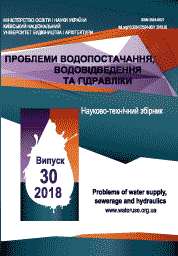The examples of hydraulic calculations of pressure collecting and distributing perfo-rated pipelines
DOI:
https://doi.org/10.32347/2524-0021.2018.30.31-35Ключові слова:
liquid discharge, perforated pipeline, hydraulic coefficient of friction, resistance coefficientАнотація
The examples of detailed engineering calculation of pressure collecting and distributing perforated pipelines with a constant diameter and with a constant intensity of perforation of the side walls along the length are presented in the article. The proposed calculation dependencies were obtained by the authors on the basis of solving a system of initial differential equations that describe the motion of a fluid with a variable flow rate in pressure channels and the conditions for the fluid passing through their side walls. The differential equation of fluid motion with a variable mass is used as the first equation. As the second, the equation of continuity in the form of the equation for the fluid outflow through holes or perforation slots. In the first example, the calculation of collecting pipelines that operate with fluid attachment along the path is considered. In the second – distributing pipelines, which distribute the liquid through its side surface. The proposed methods can be used to calculate short, long pipes and pipes of intermediate length. As the result of calculations, discharges and pressures are found in arbitrary sections of pipes. In addition, these methods allow to determine the geometric characteristics of the pipes elements under consideration (diameter and length of the channel, diameter and number of perforation holes) that can provide the optimal technologically specified mode of fluid collection or distribution. In the proposed methods, the results of experimental studies of such pipes operation, conducted personally by the authors, are widely used. Namely, the empirical dependencies, auxiliary graphs and tables for determining the magnitude of the hydraulic coefficient of friction and the perforation holes discharge coefficient for the case of fluid movement with variable flow along the path are quite simple and convenient to use. The calculation results are in good agreement with the existing experimental data.Посилання
Vasilenko, A. A., Kravchuk, A. M. (1991). Hydraulic calculation of collecting pipelines in water supply and wastewater disposal structures. Hydraulics and Hydraulic Engineering, 52, 57-61 [in Russian].
Kravchuk, A. M. (2003). Calculation of perforated distribution pipelines of arbitrary length. Scientific Herald of Construction, 20, 72-78 [in Russian].
Kravchuk, A. M., Kravchuk, O. Y. (2015). To the method of hydraulic calcula-tion of pressure distribution perforated pipe-lines in water supply and drainage systems. Problems of Water supply, Sewerage and Hydraulic, 25, 117-124 [in Ukrainian].
##submission.downloads##
Опубліковано
Як цитувати
Номер
Розділ
Ліцензія
Автори, які публікуються у цьому журналі, погоджуються з наступними умовами:
a) Автори залишають за собою право на авторство своєї роботи та передають журналу право першої публікації цієї роботи, яка через 70 років після смерті останнього співавтора з дати публікації автоматично стає доступною на умовах ліцензії Creative Commons Attribution License, котра дозволяє іншим особам вільно розповсюджувати опубліковану роботу з обов'язковим посиланням на авторів оригінальної роботи та першу публікацію роботи у цьому журналі.
b) Автори мають право укладати самостійні додаткові угоди щодо неексклюзивного розповсюдження роботи у тому вигляді, в якому вона була опублікована цим журналом (наприклад, розміщувати роботу в електронному сховищі установи або публікувати у складі монографії), за умови збереження посилання на першу публікацію роботи у цьому журналі.
c) Політика журналу дозволяє і заохочує розміщення авторами в мережі Інтернет (наприклад, у сховищах установ або на особистих веб-сайтах) рукопису роботи, як до подання цього рукопису до редакції, так і під час його редакційного опрацювання, оскільки це сприяє виникненню продуктивної наукової дискусії та позитивно позначається на оперативності та динаміці цитування опублікованої роботи (див. The Effect of Open Access).


